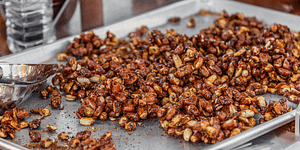Three Recipes for Dried Tomatoes

Now is the perfect time to think about drying and preserving your gardening season bounty! Get the ball rolling with these recipes for dried tomatoes.
The following recipes are from Preserving Food without Freezing or Canning by the Gardeners & Farmers of Terre Vivante. They have been adapted for the web.
Tomatoes Dried Naturally
- Tomatoes
- Almond oil (or another mild oil)
- A clean rag
- Drying apparatus
- A glass jar

Peel the tomatoes. (If this poses a problem, soak them for a few seconds in boiling water.) Cut them lengthwise (from bottom to top) into slices approximately 1/4-inch thick and remove the seeds.
Place the slices on a clean rag to absorb the juice. Oil the dryer screen lightly, preferably with mild almond oil, so that the slices will not stick. When the slices are dry on one side, turn them over; they will be hard when dry. Store the tomatoes well packed in a glass jar.
To use, pour one cup of boiling water over one-half to three-quarter ounces of dried tomatoes per person, and leave them to soften for a few minutes. Add a teaspoon of olive oil, season to your tate, and serve with a purée or a grain dish. We also add these tomatoes to grains or vegetables that are nearly done cooking.
—Odile Angeard, Cognin
Stuffed Dried Tomatoes in Oil
- Tomatoes
- Parsley
- Garlic
- Anchovy fillets (optional)
- Fresh basil leaves (optional)
- Oil
- Drying apparatus
- A glass jar
I dry my tomatoes in a solar dryer, cut in half and seeded (easily done with a small spoon). When the tomatoes are dry, stuff a little finely chopped parsley and garlic between the two halves.
If you like, add an anchovy fillet, or a basil leaf. Place the reassembled tomatoes in a jar and cover with oil. These are delicious added to a salad during winter.
—Anonymous
Sun-Dried Tomatoes in Oil
Variation 1:
- 4 lbs. tomatoes
- 1 lb. coarse salt
- Oil
- Drying apparatus
- Gauze
- A clean, dry cloth
- Glass jars

Cut the tomatoes in half, place them on a tray set in the sun, add salt, and cover with gauze to protect from insects. During the day, turn the tomatoes over twice; at night, bring them inside to protect from moisture.
A few days later, when you see that they are very dry but not totally dehydrated, remove some of the salt with a clean, dry cloth.
Put the tomatoes into jars and cover them with approximately three-quarters of an inch of oil over the tomatoes, coming up to three-eights of an inch below the rim.
Close the jars tightly and store them in a cool place. In Italy, tomatoes preserved in this manner are eaten as hors d’oeuvres, with no additional preparation.
Marie-Christine Martinot-Aronica, St. Dizier
Variation 2:
- Tomatoes
- Vinegar
- Hot peppers, mint leaves, or whole garlic cloves (optional)
- Oil
- Drying apparatus
- A glass jar
Choose tomatoes that are firm and completely intact, preferably plum tomatoes. Cut them in half lengthwise. Allow them to dry on trays in the sun, bringing them in whenever it is humid, and in at night to avoid dampness. When they are dry, soak the tomatoes in warm vinegar for twenty minutes.
Drain and put them in a jar, alternating layers of tomatoes with one or two hot peppers, mint leaves, or whole cloves of garlic. Press well to allow any air to escape, and then cover with oil. These tomatoes will keep for a very long time. We eat them as hors d’oeuvres or with rice, pasta, meat, or fish.
—Babette Cezza, Vergt
Recommended Reads
Recent Articles
What’s so great about oyster mushrooms? First, you can add them to the list of foods that can be grown indoors! They are tasty, easy to grow, multiply fast, and they love a variety of substrates, making oyster mushrooms the premium choice. The following is an excerpt from Fresh Food from Small Spaces by R. J.…
Read MoreCraving something sweet? These delicious maple roasted nuts are the perfect treat to help you push through those end-of-winter blues. The following is an excerpt from Full Moon Feast by Jessica Prentice. It has been adapted for the web. The Magic of Maple: A Rich History Following the Hunger Moon, just before the first thaw…
Read MoreDoes the cold weather have you dreaming about fresh greens and colorful salad? Grow and harvest sprouts indoors to make those dreams a reality! Follow this quick start guide to year-round greens for fresh salad greens in just a couple of weeks! The following is an excerpt from Year-Round Indoor Salad Gardening by Peter Burke. It…
Read More








